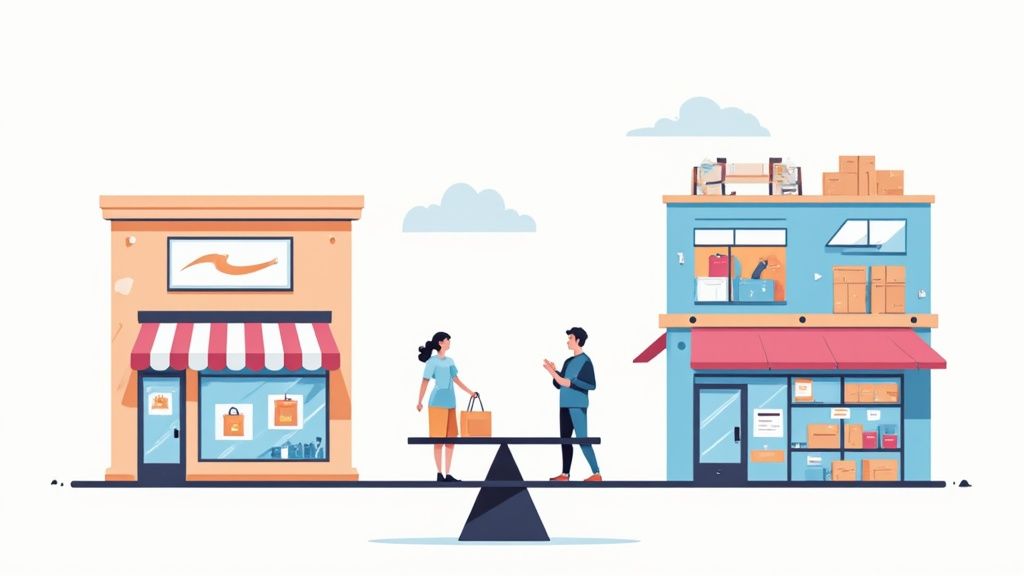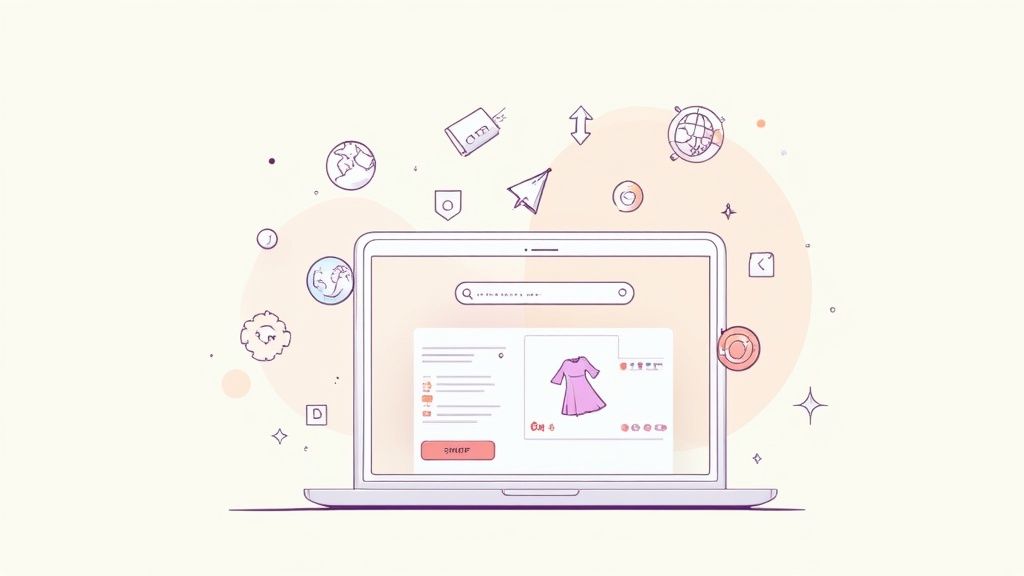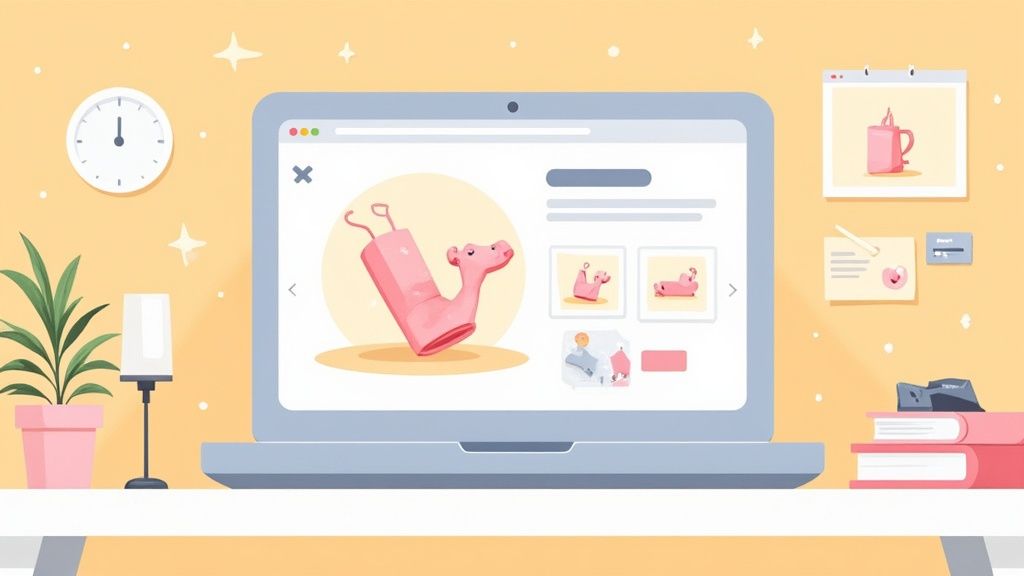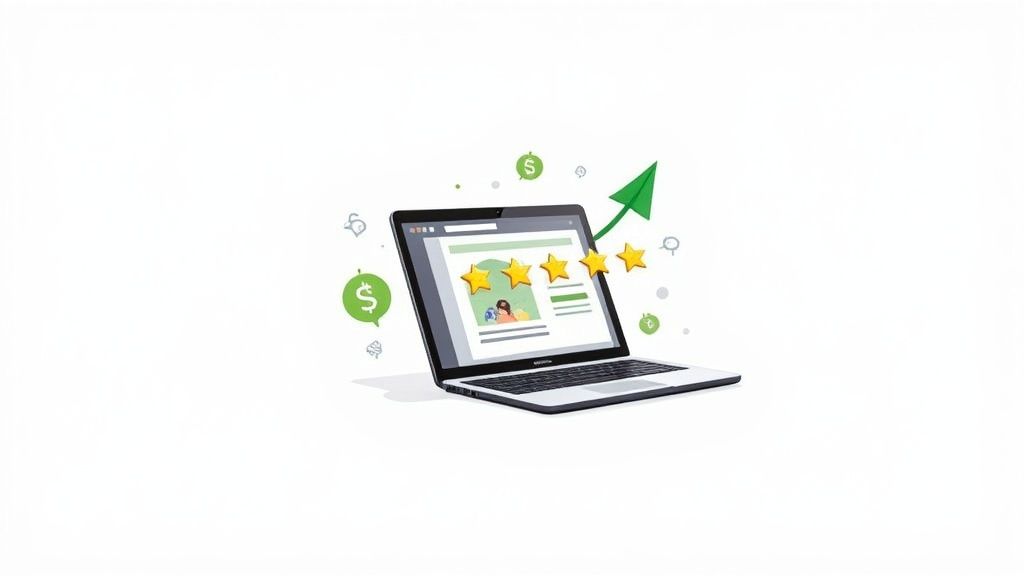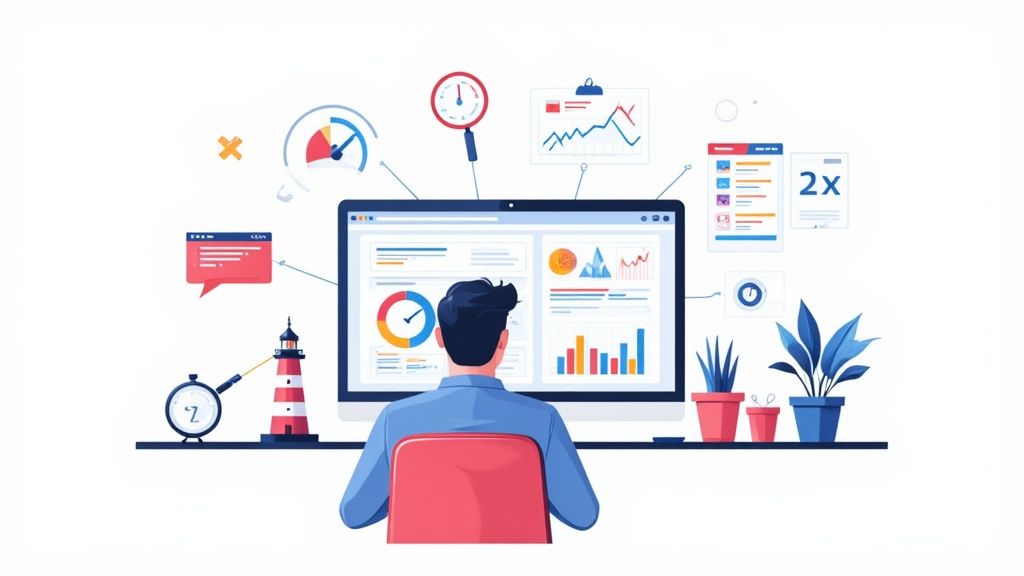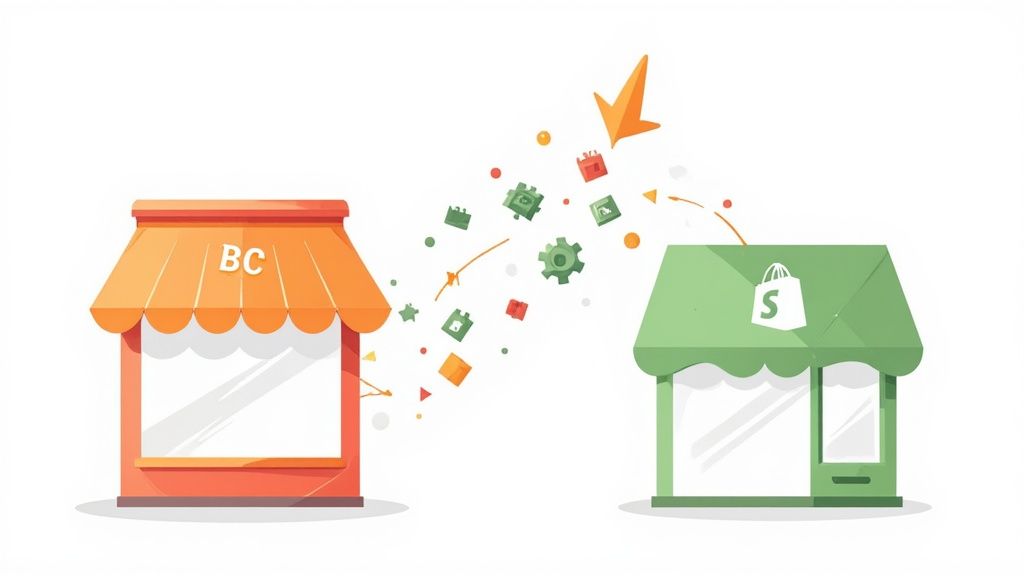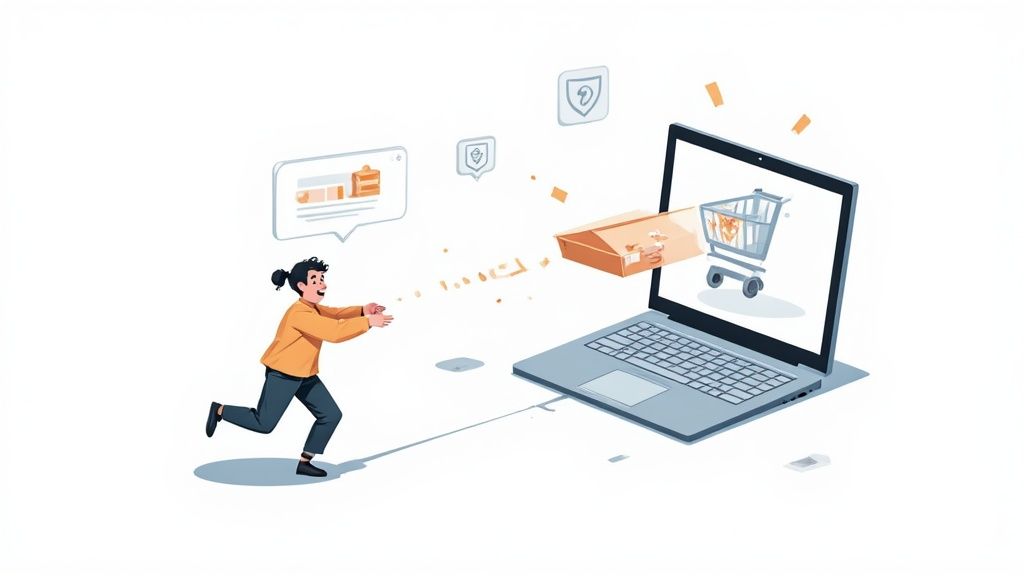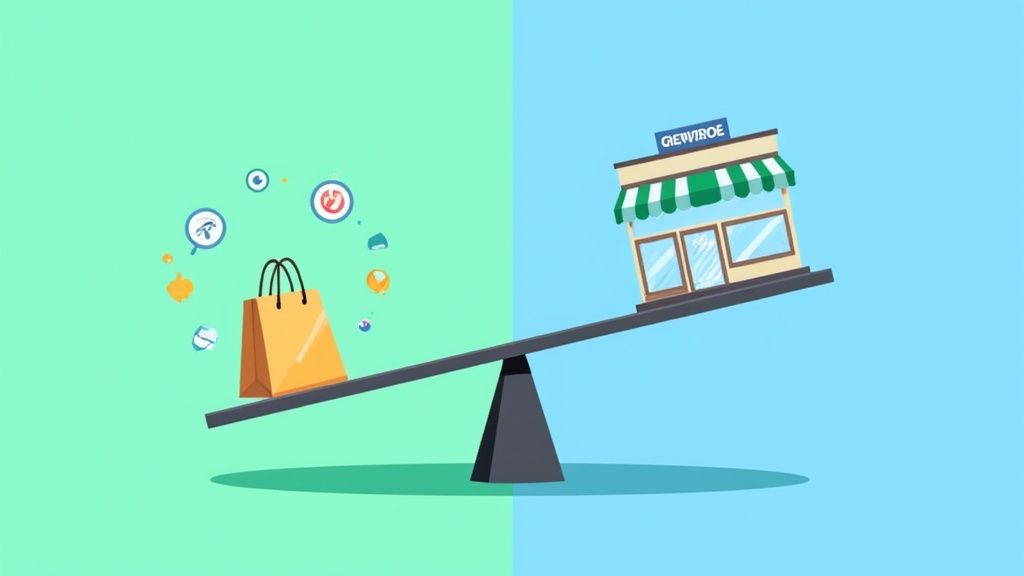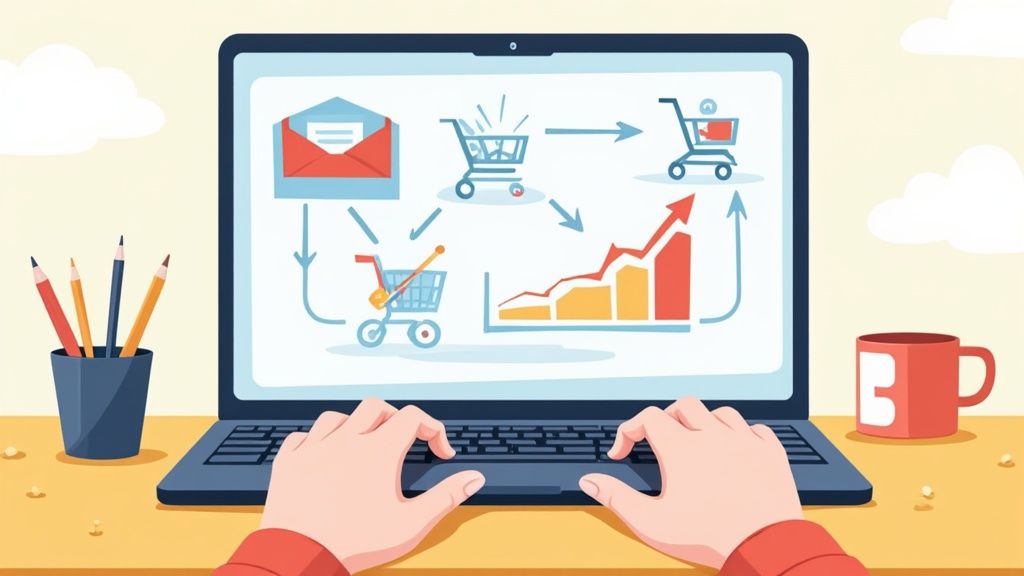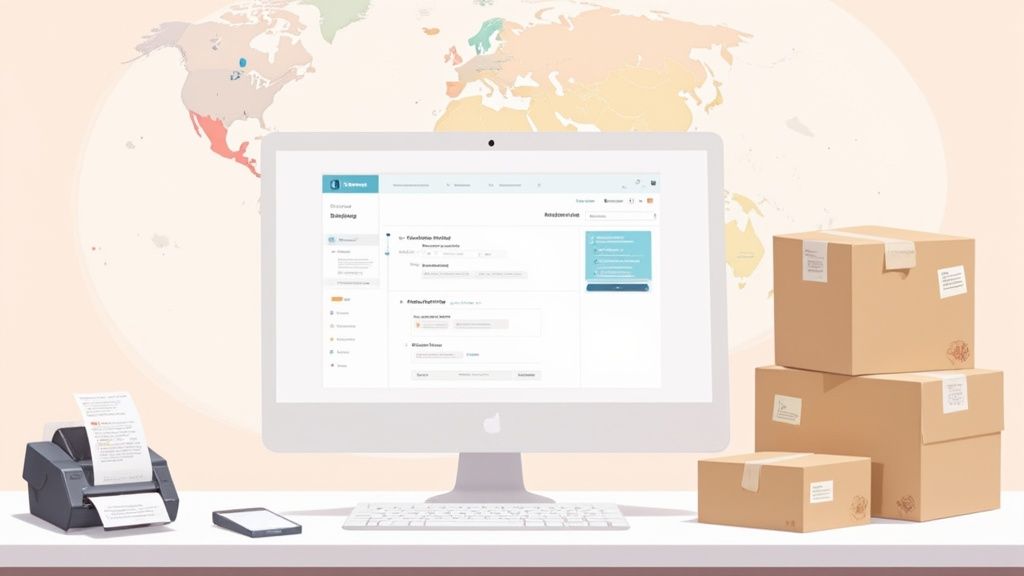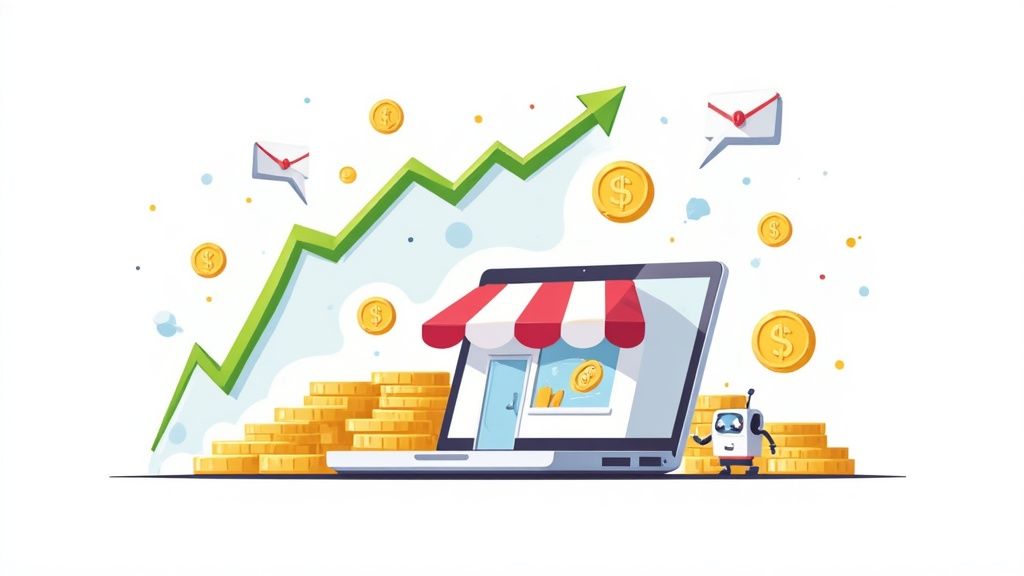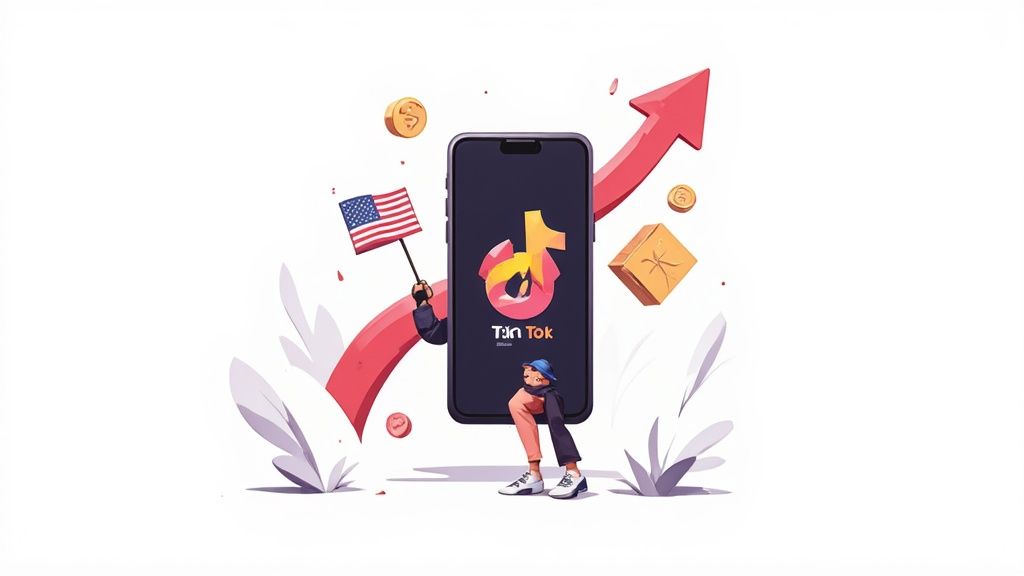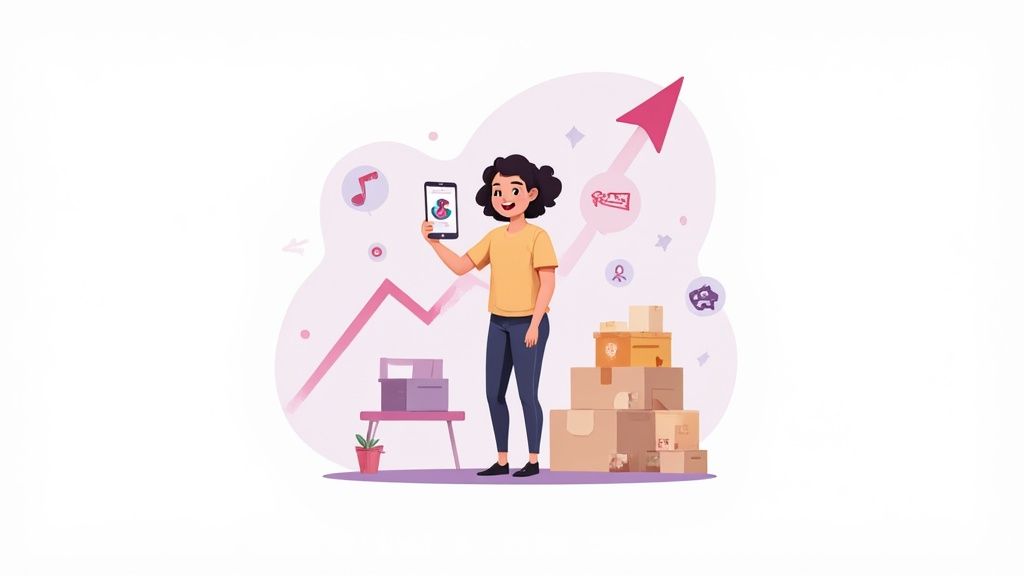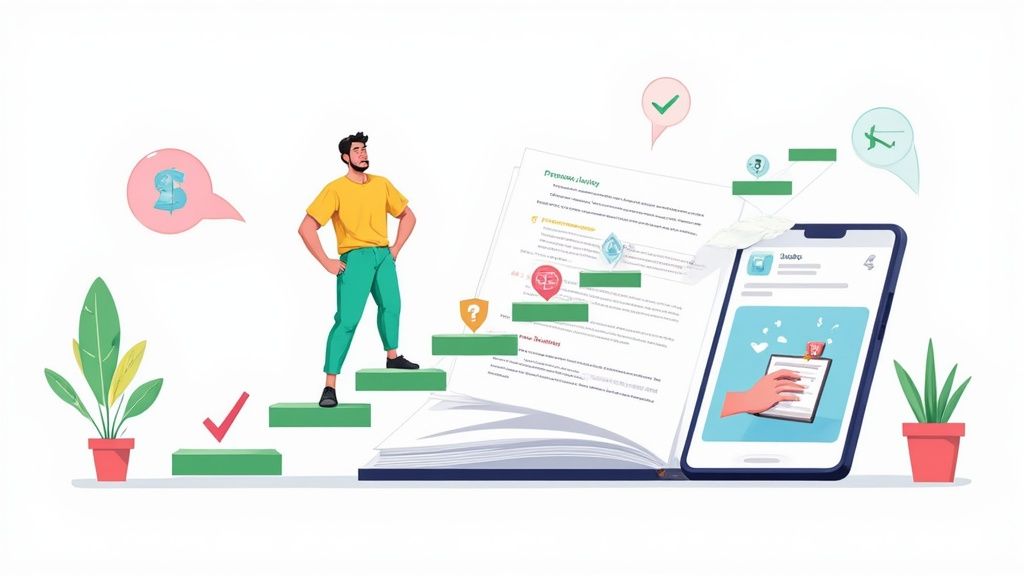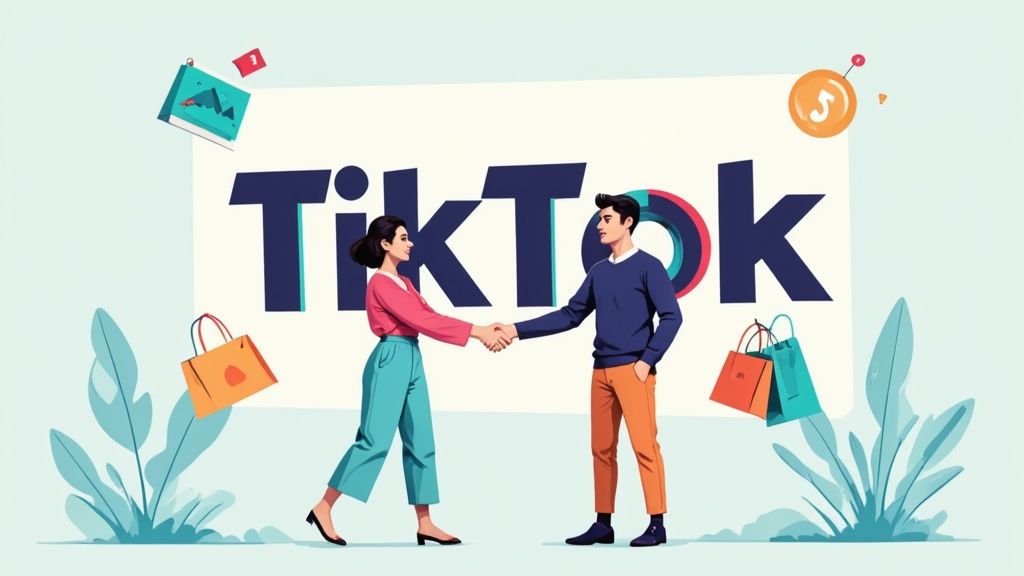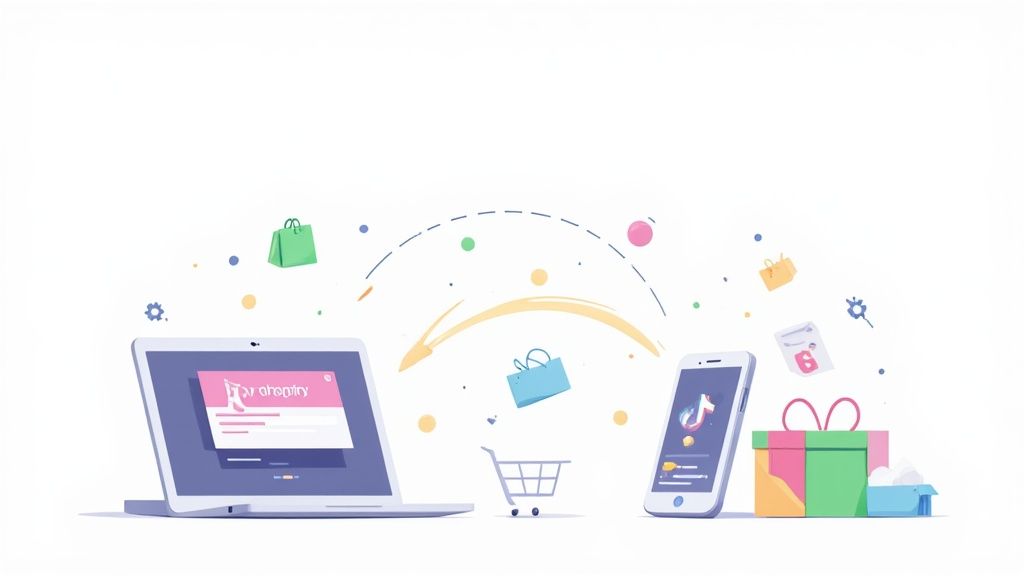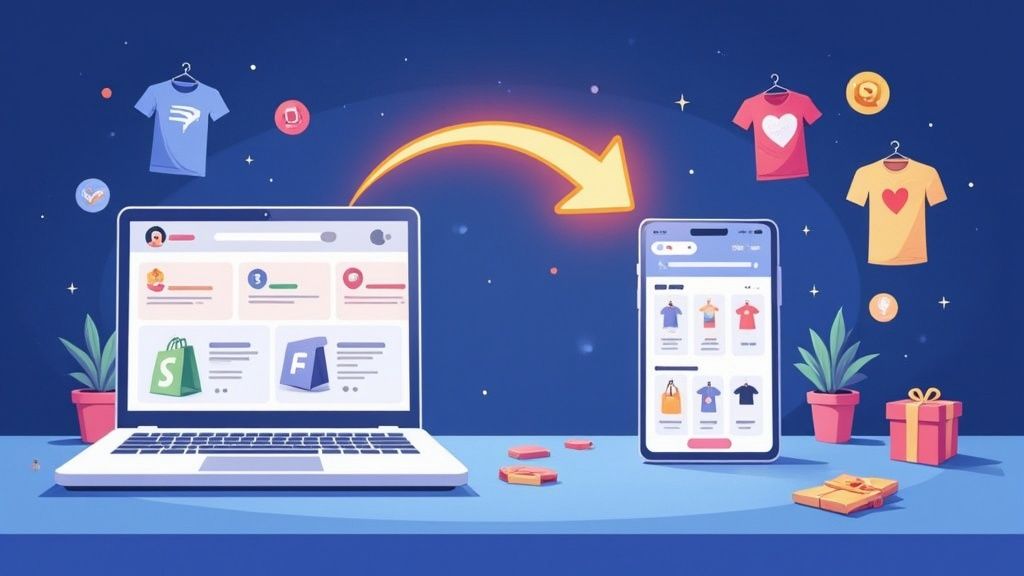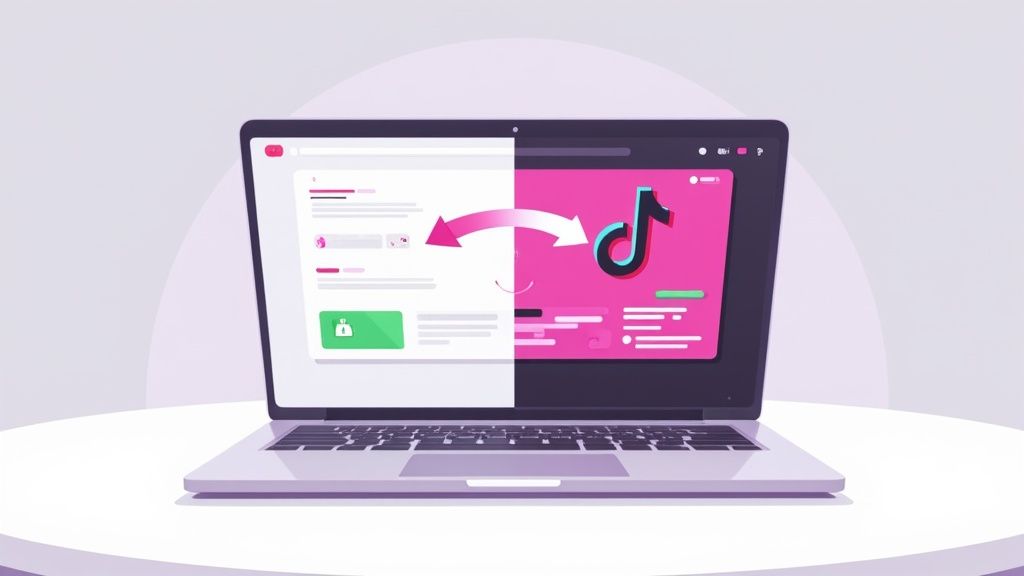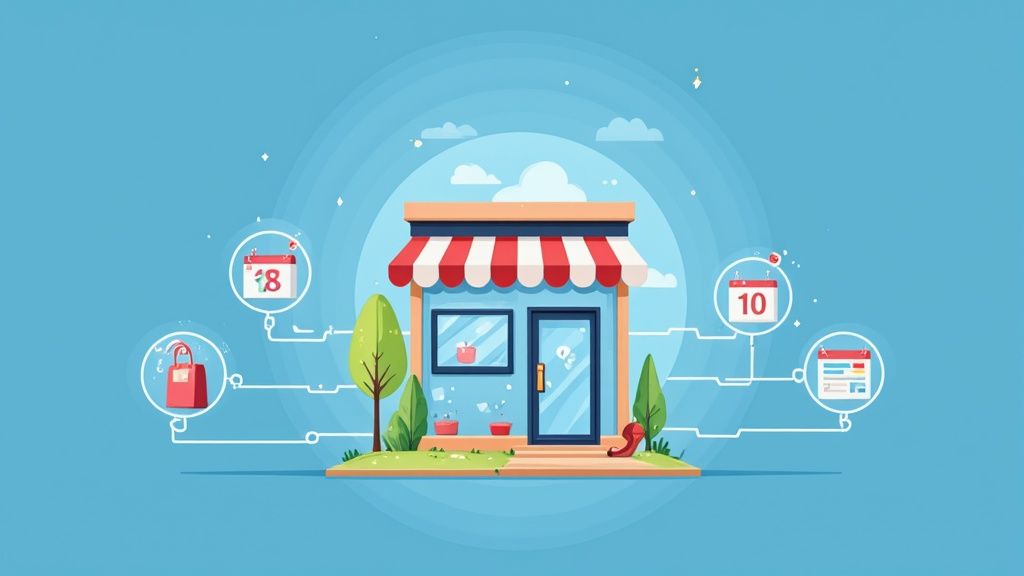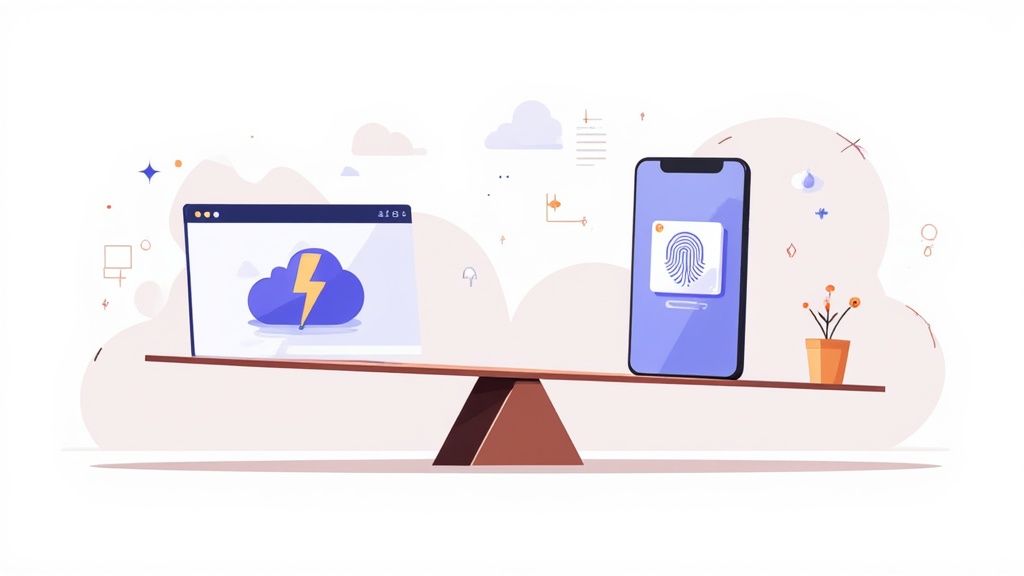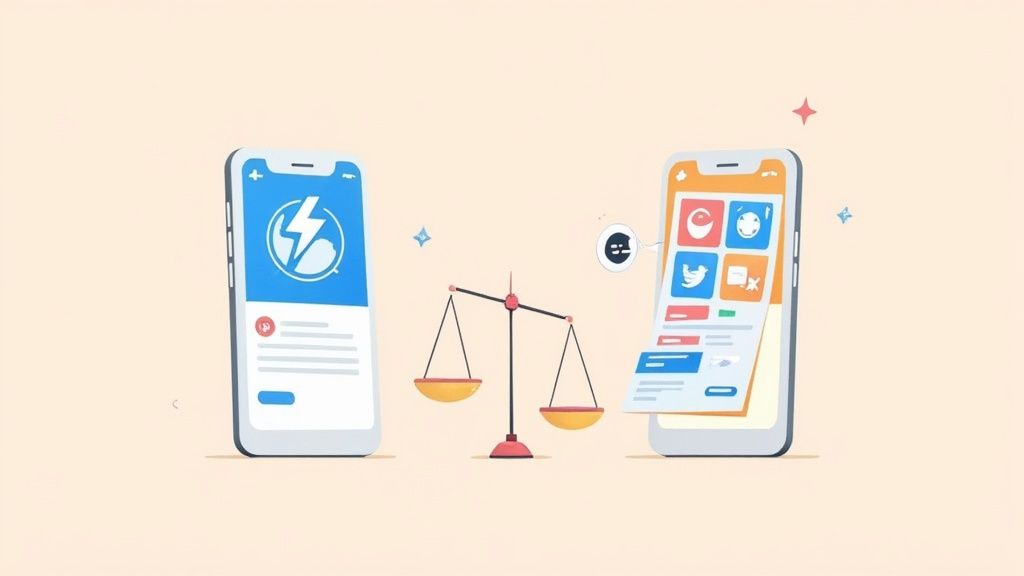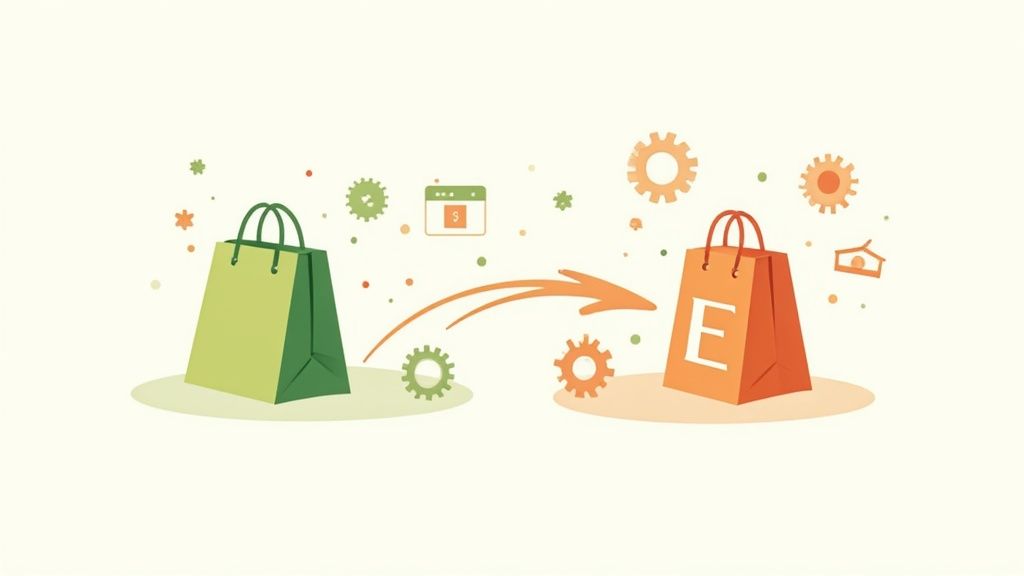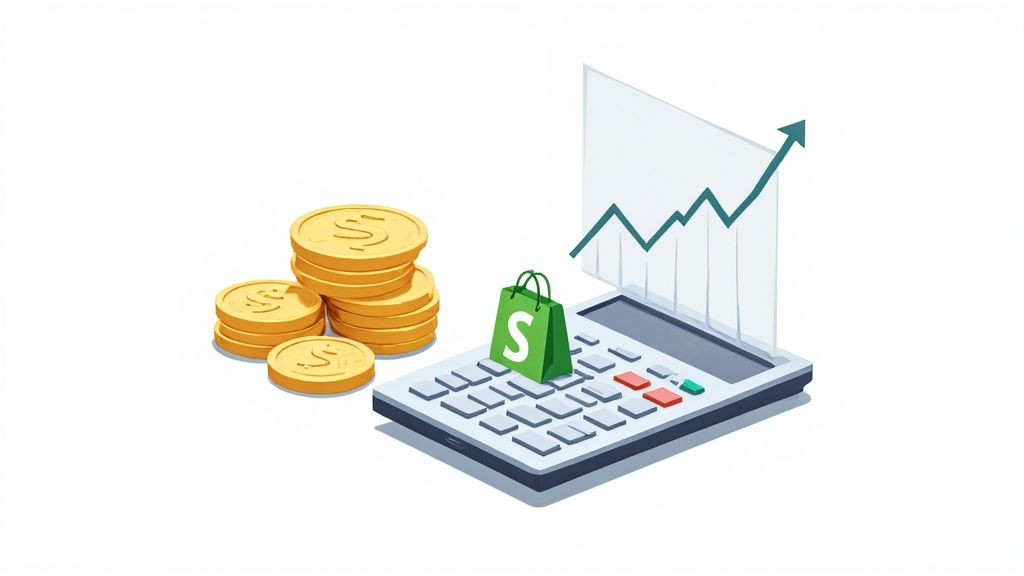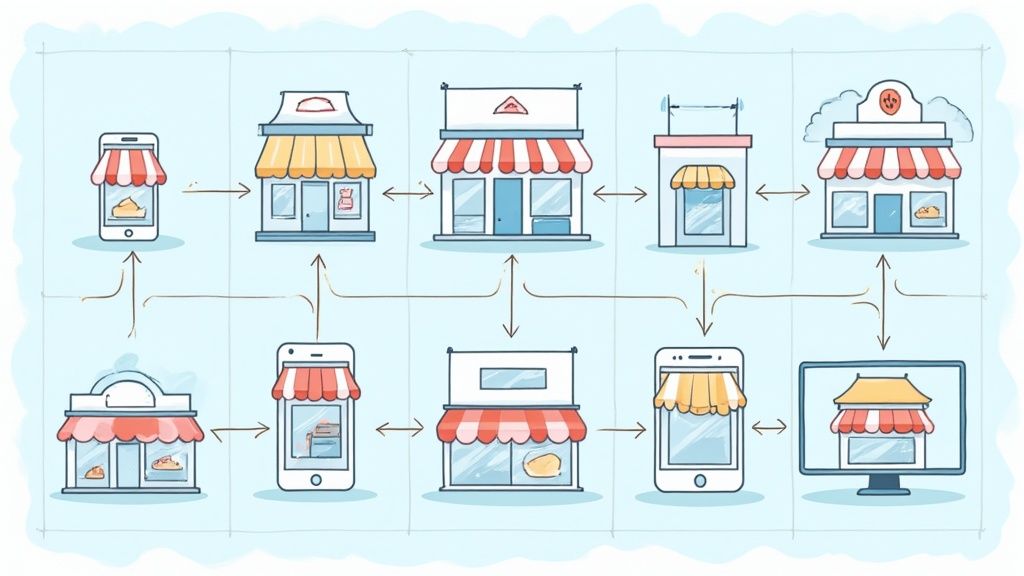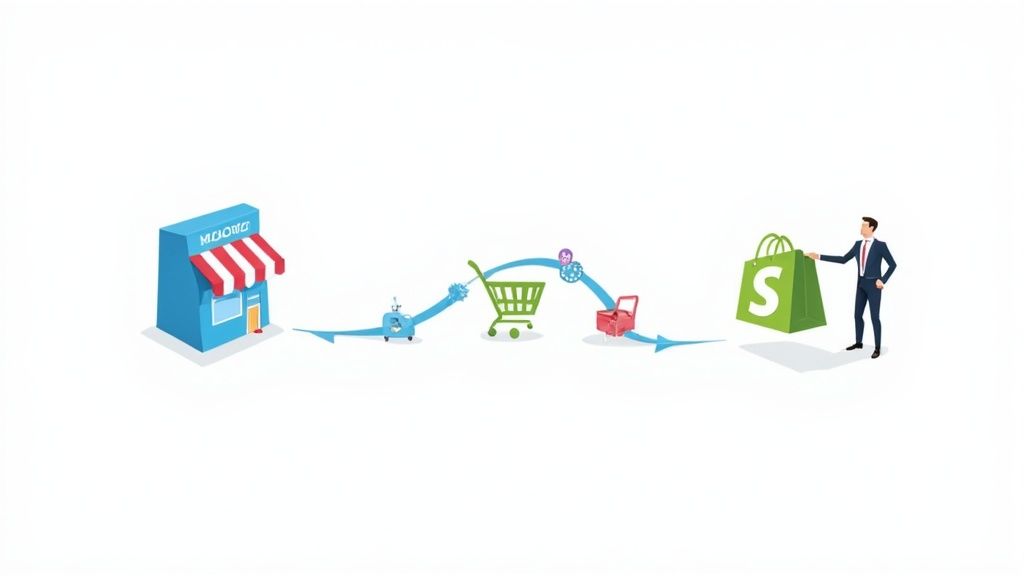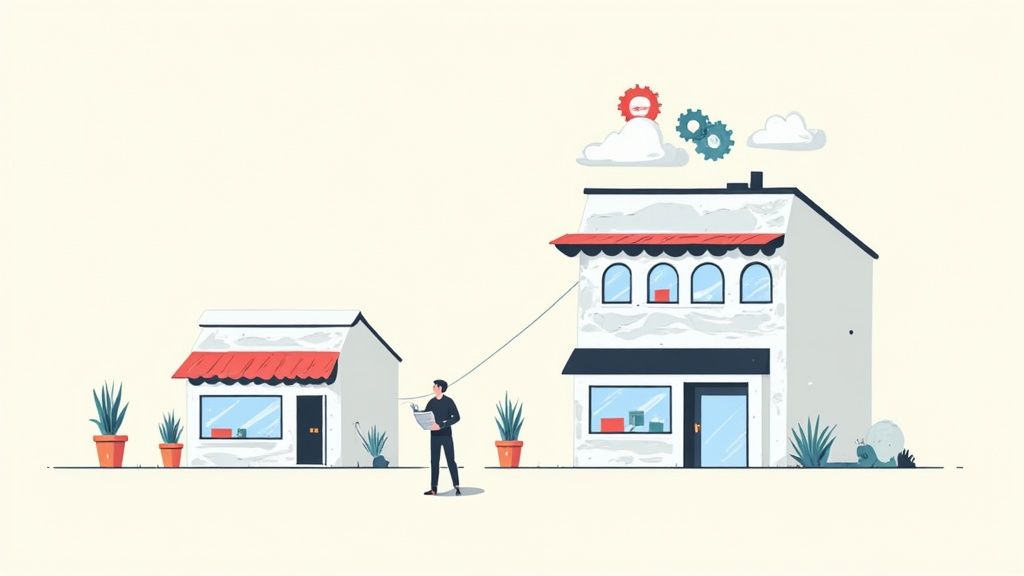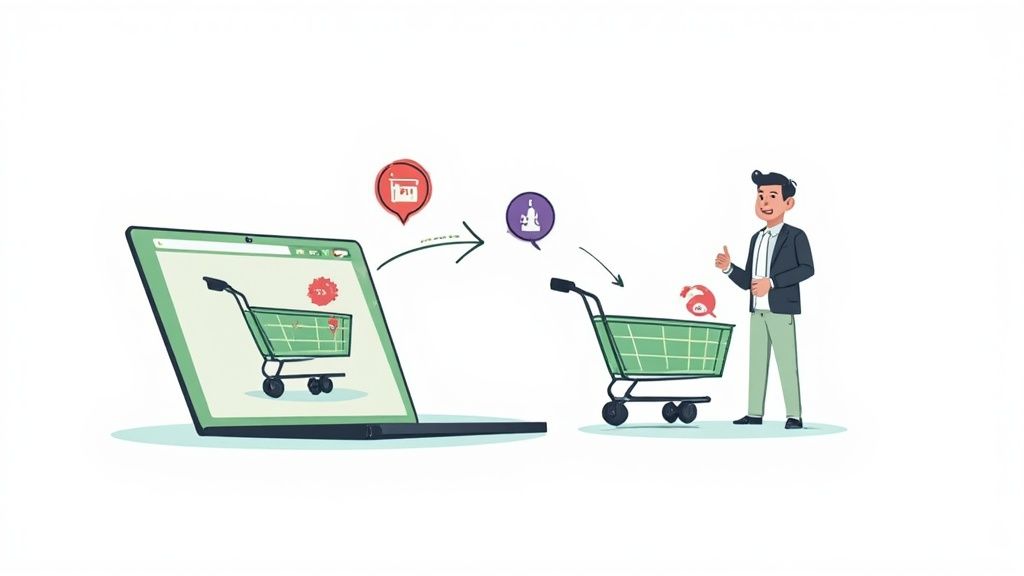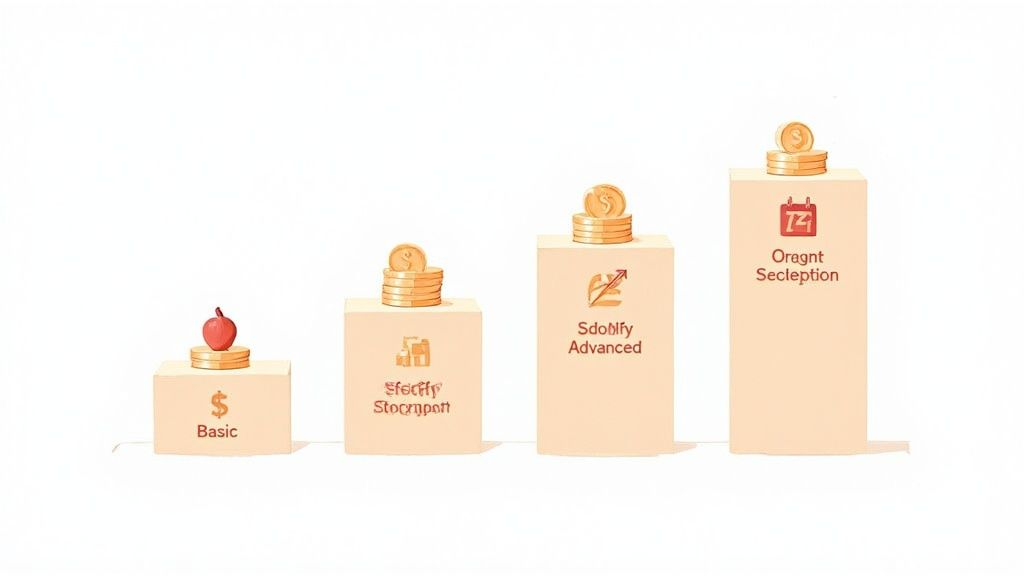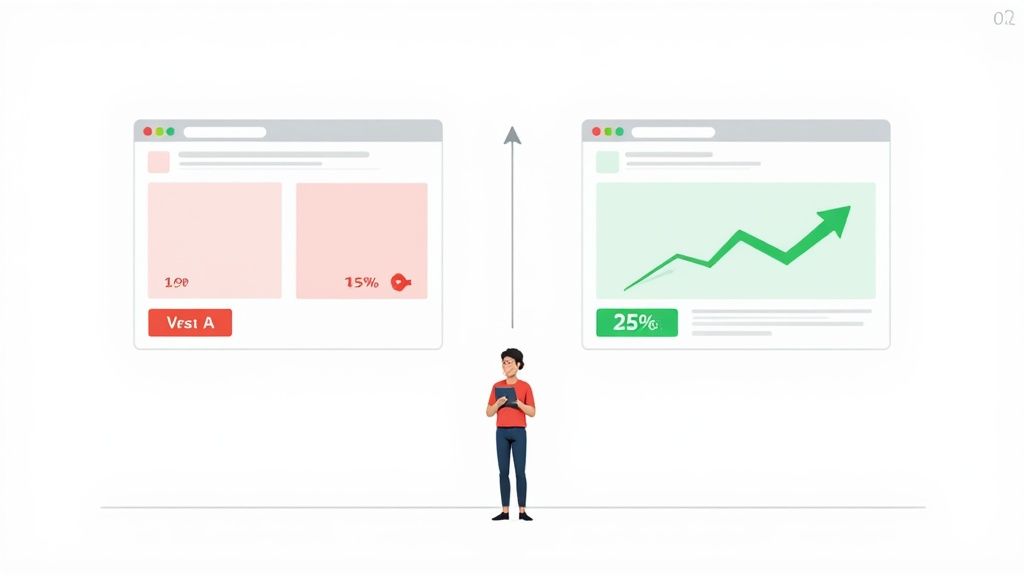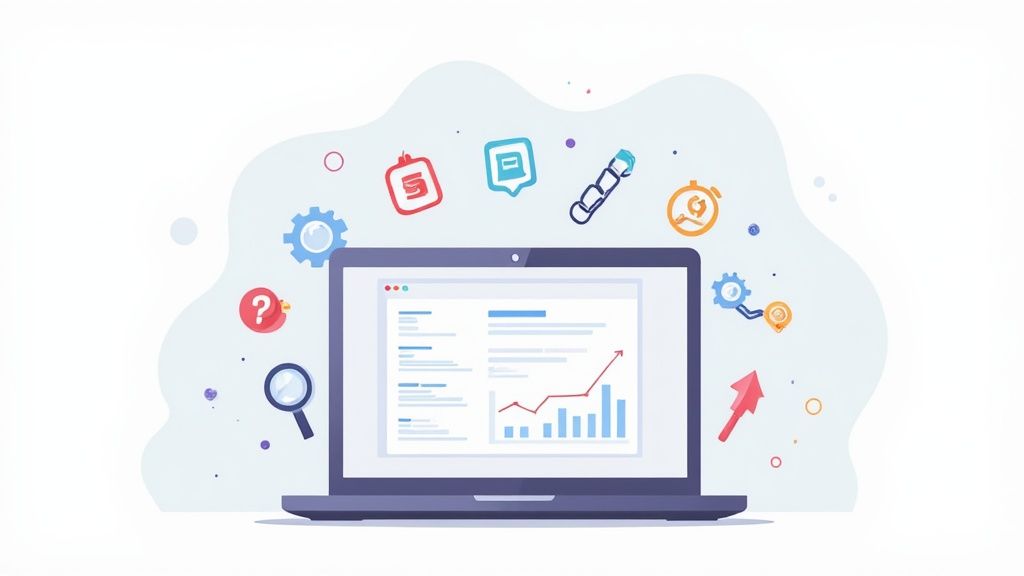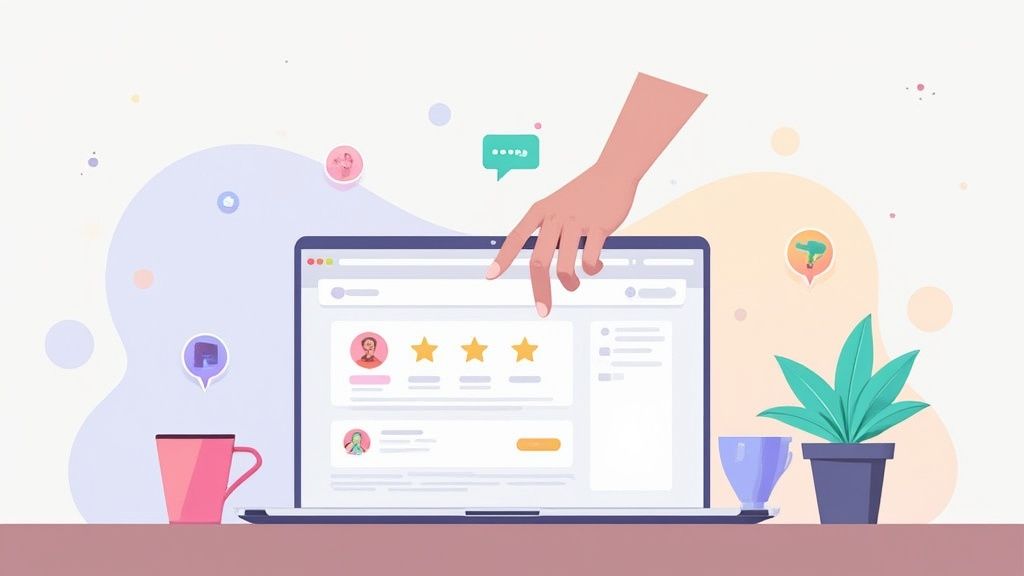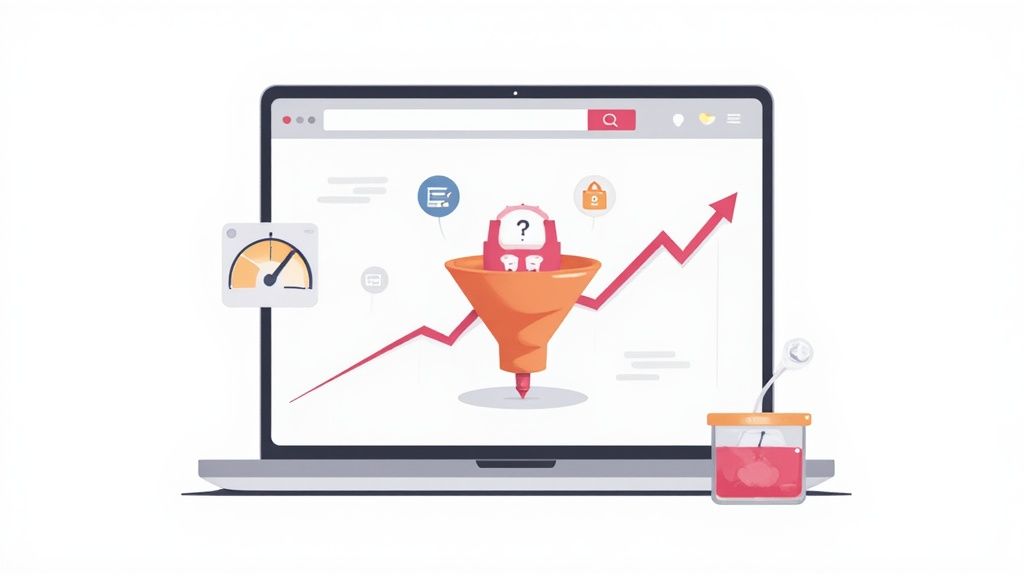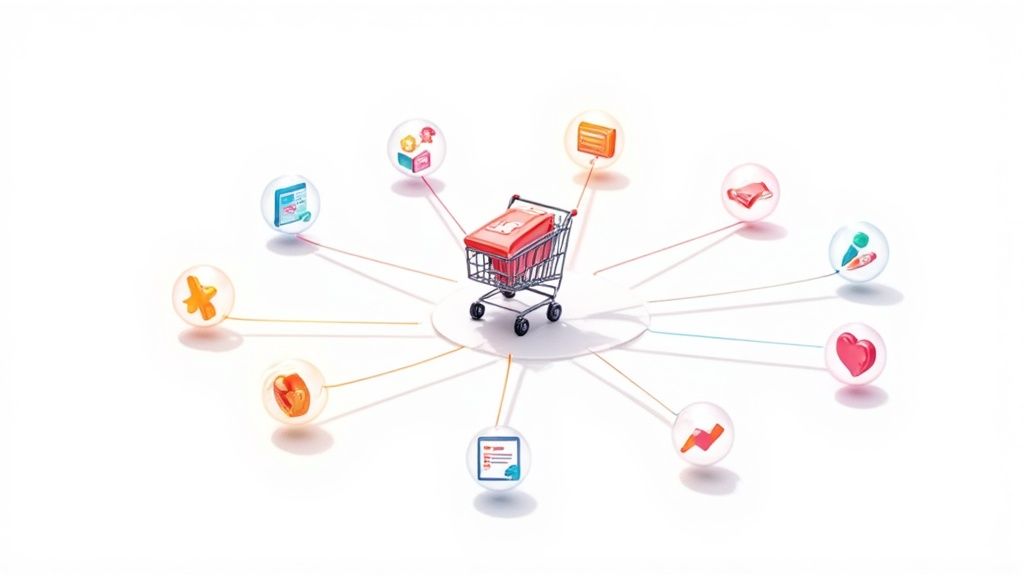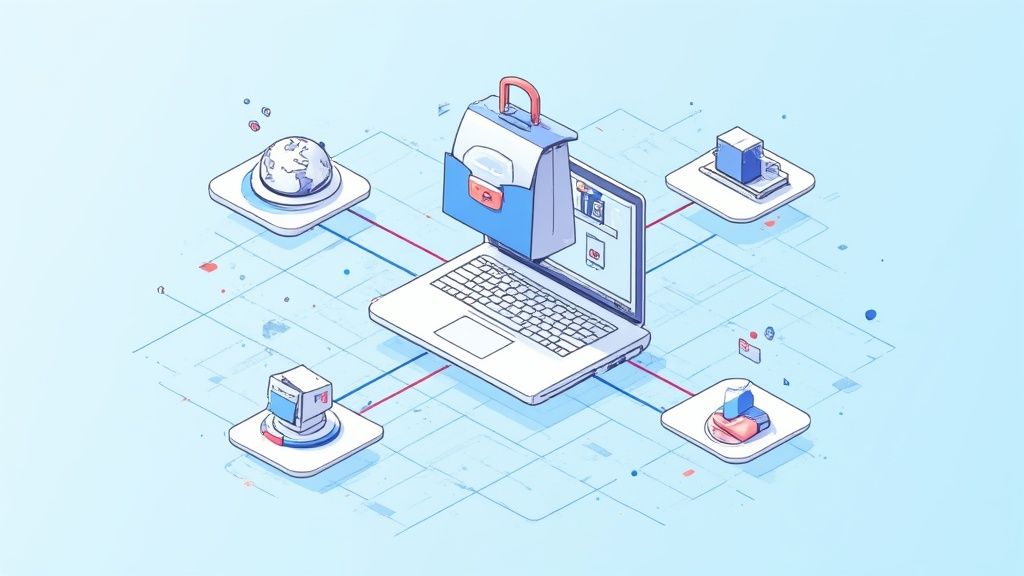
Deciding to manage multiple stores in Shopify is a big deal. It's often a sign that a successful brand is ready to diversify or take on the world. This isn't just about spinning up another website; it's about crafting entirely separate, targeted experiences for different audiences—and managing all the operational headaches that come with it.
When Do Multiple Shopify Stores Actually Make Sense?
Juggling more than one Shopify store means more costs and more work, so it’s not a decision to take lightly. It’s a powerful play, but only when the business case is crystal clear. Before you even think about hitting "create new store," you need to know exactly why you're doing it and if it gives you a real competitive edge over simpler alternatives.
The biggest driver is almost always the need for total brand separation.
Let's say you've built a successful business selling high-end, minimalist home decor. If you suddenly decide to launch a new brand for quirky, colorful pet accessories, putting them under the same digital roof is going to confuse everyone. The branding, the marketing voice, the target customer—they're worlds apart. In a scenario like this, a second, completely distinct Shopify store is the only logical move.
This separation is also critical for different business models. A classic example is splitting your direct-to-consumer (D2C) and business-to-business (B2B) or wholesale operations. These two groups have completely different shopping needs:
- D2C Customers: They want a beautiful, simple site with standard pricing and a quick, easy checkout.
- B2B Customers: They need features like tiered pricing, bulk order forms, net payment terms, and often a password-protected portal to even see the products.
Trying to cram both experiences into one store usually results in a clunky, compromised mess for everyone. By running separate D2C and B2B stores, you can tailor every single detail of the journey, from the homepage messaging right down to the payment options, for each specific audience.
The International Expansion Question
Going global is another common reason merchants start thinking about a multi-store setup. For a long time, it was the only real way to offer truly localized experiences. But things have changed.
For many brands, the main goal is just to sell in different currencies and languages. This is where a tool like Shopify Markets really shines. It lets you manage all your international sales from a single backend, offering up localized domains, currencies, and languages without the massive overhead of running completely separate stores.
This screenshot gives you a peek at the Shopify Markets interface, which is designed to manage global sales from one central dashboard.
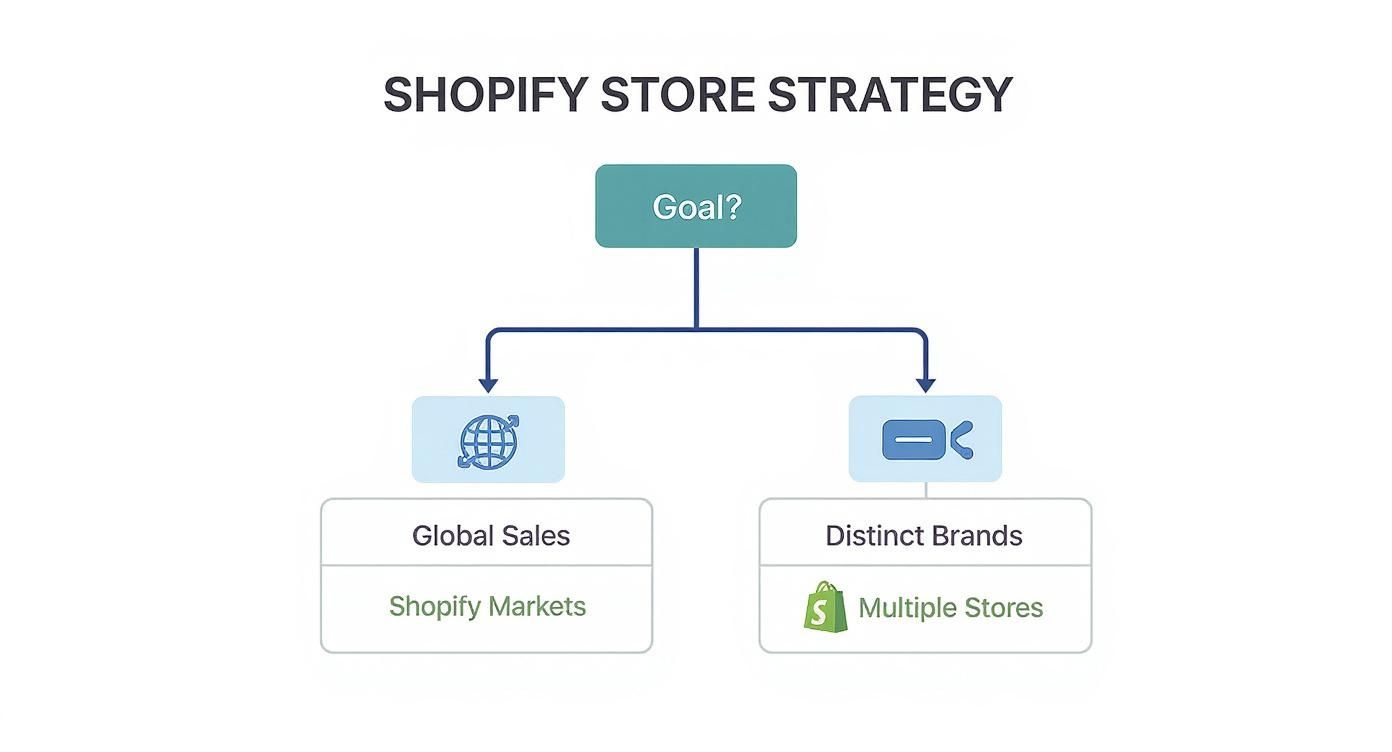
The bottom line is that Shopify Markets provides a centralized, streamlined way to handle localization, making international commerce much simpler than it used to be.
That said, if your international strategy is more complex—requiring completely different product catalogs, unique marketing campaigns, or navigating thorny legal compliance for each region—then multiple stores are still the way to go.
Multiple Stores vs Single Store with Shopify Markets
To help you decide, let's break down the key differences between these two approaches. This table gives a head-to-head comparison to help you match the right strategy to your expansion goals.
Ultimately, if you need total separation for branding, business models, or deep regional control, multiple stores are your best bet. For streamlined international growth under a single brand, Shopify Markets is the more efficient choice.
Looking at the data, you can see how merchants deploy multiple stores across different niches. Apparel is the top category with 528,255 Shopify stores, followed by Home & Garden with 229,262 stores, and Beauty & Fitness with 198,041 stores. These figures show that even within popular categories, merchants often run multiple stores to hit different customer segments or price points. You can dig deeper into this Shopify data and how it reflects market strategies.
Designing Your Multi-Store Architecture
A successful multi-store operation starts with a solid foundation. Before you spin up a second, third, or even tenth store, you need a strategic blueprint that dictates how they will all connect, operate, and scale together.
Winging it is a recipe for operational chaos. Trust me, taking the time to design your architecture upfront will save you countless hours and headaches down the road.
This planning phase is more critical than ever, as merchants are increasingly using multiple Shopify stores to capture new markets. Shopify's own growth tells this story; as of early 2025, the platform hosts over 5.5 million active stores. But when you factor in all the multi-store setups and subdomains, that number jumps to over 9.6 million active storefronts. It’s a clear trend: sellers are using separate storefronts to test new business models and reach diverse customer segments. You can dig deeper into these Shopify growth statistics and what they mean for merchants to see the bigger picture.
It all starts with one of the most fundamental decisions you'll make: your domain strategy.
Choosing Your Domain Strategy
Your domain structure directly impacts your branding, SEO, and how customers perceive you. You have two primary paths to choose from, and each one is suited for different business goals.
Subdomains for Regional Stores: This approach uses a format like
us.yourbrand.com,uk.yourbrand.com, andca.yourbrand.com. It’s a fantastic choice for international expansion under a single, unified brand. The main benefit here is that it keeps your primary brand name front and center, reinforcing a global presence while still signaling localization to customers. Search engines also recognize the relationship between subdomains and the main domain, which can help consolidate domain authority over time.Separate Domains for Distinct Brands: If you're launching entirely different brands—say, one for luxury leather goods (
brand-a.com) and another for affordable pet toys (brand-b.com)—then separate domains are a must. This strategy creates total brand separation, preventing any customer confusion and letting you build unique identities from the ground up. Each domain will have its own SEO footprint, marketing channels, and customer base.
Pro Tip: Don't mix and match these strategies without a crystal-clear reason. If you’re selling the same brand internationally, stick with subdomains. If you're managing a portfolio of different brands, use separate root domains. Consistency is key for both user experience and your technical SEO.
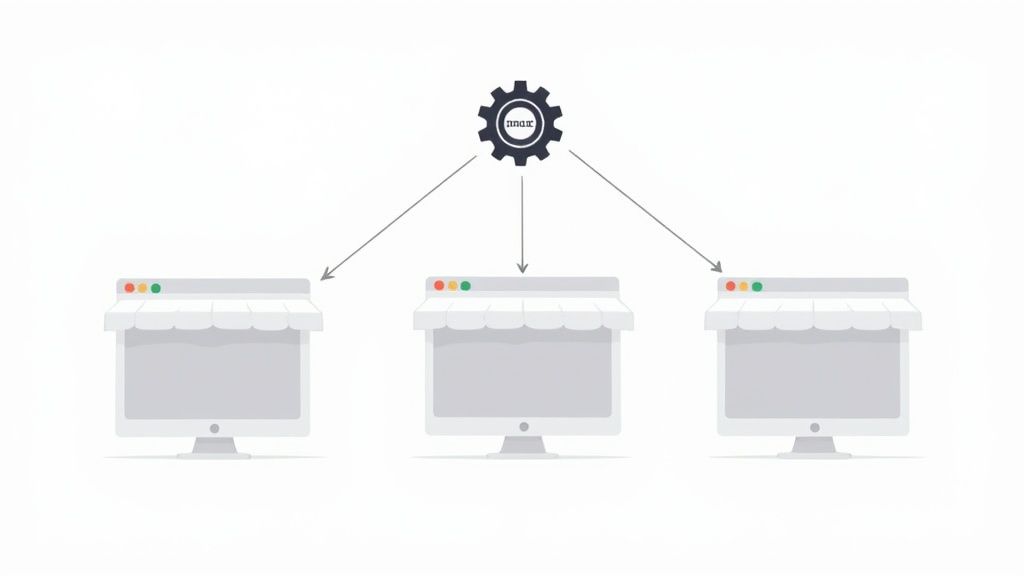
Building Your Technical Foundation
With your domain strategy locked in, the next step is deciding how to build out the new store itself. You aren't just creating another website; you're building a scalable system. Here again, you have a couple of core options.
One path is to clone your existing store. This is often the fastest way to get a new regional store up and running. Using an app like Rewind Staging, you can copy over your theme, settings, products, and even blog posts in one go. This method is ideal when the new store will be very similar to the original, maybe just with minor tweaks for a new currency or language.
The alternative is to start from a fresh Shopify instance. This is the better choice when launching a completely new brand, or when your existing store's theme and app ecosystem have become bloated and messy over time. A fresh start lets you build a clean, optimized foundation specifically for the new store's needs, without carrying over any technical debt. You can explore more about the nuances of this setup in our comprehensive guide to managing Shopify multiple storefronts.
Establishing a Master Theme and Data Process
Whether you clone or start fresh, establishing a "master" or "parent" theme is a powerful strategy for maintaining consistency. This just means having a core theme that you customize and then roll out across your different stores.
When you need to make a global update—like adding a new promotional banner feature or changing the footer—you make the change in the master theme first. You test it, then deploy it to your other stores. This centralized approach prevents your branding from drifting apart and dramatically speeds up development time.
Finally, you absolutely must define a central process for product information management (PIM). Decide where your "single source of truth" for product data will live. Will you update product descriptions, images, and pricing in one "master" store and then sync those changes to the others with an app? Or will you use a dedicated PIM tool?
Without this process, you will inevitably end up with inconsistent product data across your stores, leading to customer confusion and a ton of operational errors.
Unifying Inventory and Order Management
So you're running multiple Shopify stores. That’s a fantastic sign of growth, but it comes with a major operational headache: keeping your inventory and orders in perfect sync. When your stores aren't talking to each other, you inevitably oversell popular items. That leads to canceled orders, frustrated customers, and a logistical nightmare for your support team. A disconnected system isn't just inefficient—it actively hurts the customer experience you've worked so hard to build.
The root of the problem is simple: by default, each Shopify store operates as an island with its own isolated inventory pool. A sale on your US store doesn't automatically tell your UK store to update its stock count. This is where the real work begins—creating a single source of truth for your stock and a streamlined process for fulfillment, no matter which storefront an order comes from.
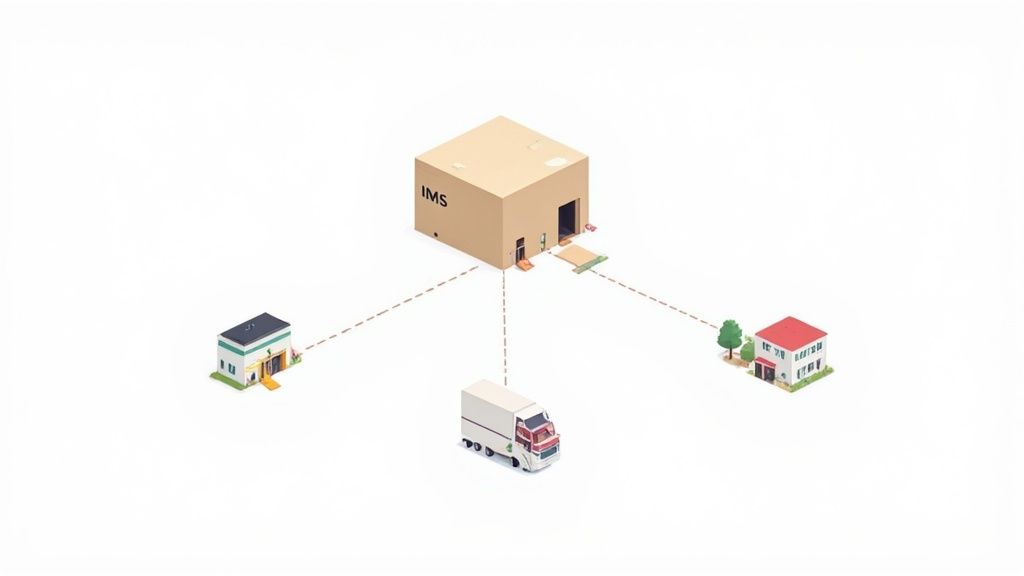
Establishing a Single Source of Truth
To stop overselling in its tracks, you need to pick one system to be the undisputed master of your inventory data. This "single source of truth" is the central record that all your storefronts will listen to. For most brands that are scaling up, this usually means one of two paths.
The most bulletproof solution is a dedicated Inventory Management System (IMS) or an Enterprise Resource Planning (ERP) platform. Think of these as the command center for your entire operation. They pull data from all your sales channels, warehouses, and suppliers into a single, powerful dashboard. It's a significant investment, no doubt, but an ERP provides a level of accuracy and control that's hard to beat as your order volume explodes.
But let's be realistic—not every business is ready to jump into a full-scale ERP. The good news is, you don't have to. There are some incredibly powerful apps that can solve this problem right inside the Shopify ecosystem.
Top Apps for Real-Time Inventory Sync
If you're looking for an effective, less complex solution, several Shopify apps were built specifically for multi-store inventory sync. These tools act as a bridge between your stores, making sure that when an item sells on one, the stock level is updated across all the others in near real-time.
One of the most popular and reliable tools for this is Syncio Multi Store Sync. It lets you designate one "source" store as the master inventory holder. All your other "destination" stores then automatically pull their stock levels from that primary source. Simple and effective.
Here's why an app like Syncio is a game-changer:
- Real-Time Updates: This drastically cuts down the risk of overselling by updating inventory almost instantly after a sale.
- Product Data Sync: It's not just about stock numbers. You can also sync product titles, descriptions, and images to keep your branding consistent everywhere.
- Automated Order Routing: Orders from your destination stores can be automatically pushed to the source store, giving you one central place to manage fulfillment.
The goal here isn't just syncing numbers on a spreadsheet. It's about building a cohesive system where your stores act like a unified network instead of isolated silos. This kind of automation is what makes a multi-store strategy sustainable as you grow.
Creating a Centralized Fulfillment Playbook
Once your inventory is synced, the next piece of the puzzle is fulfillment. Juggling orders from multiple dashboards is a recipe for mistakes and delays. The best practice is to funnel all order processing into a single, unified workflow, no matter which storefront the sale came from.
If you're working with a Third-Party Logistics (3PL) provider, this often becomes much simpler. Most modern 3PLs can plug directly into multiple Shopify stores, pulling all incoming orders into their own system for picking, packing, and shipping. It’s a hands-off approach that frees you up to focus on growth.
For those of us managing fulfillment in-house, the strategy is much the same. You’ll want to use an app or a central platform to consolidate every order into one queue. This could be your designated "source" Shopify store or a dedicated order management system. The key is giving your team a single, clear list of what needs to be shipped, every single day.
Effective inventory management is absolutely foundational to making a multi-store setup work. To get your stock levels optimized and boost efficiency, it's always a good idea to follow essential retail inventory management best practices.
By thinking strategically about both your stock and your orders, you can sidestep one of the biggest challenges of running multiple stores. For brands that also have physical retail locations in the mix, we've put together a detailed guide on https://www.ecorn.agency/blog/multi-location-inventory-management that dives even deeper into these operational complexities.
Scaling Operations with Shopify Plus
When your brand’s growth starts straining the limits of a standard Shopify plan, managing multiple stores in Shopify can quickly feel like you're holding things together with duct tape. This is precisely the moment Shopify Plus transitions from a "nice-to-have" to an operational must. It’s built from the ground up for the kind of complexity that comes with a growing portfolio of storefronts.
Shopify Plus isn't just a souped-up version of the Advanced plan. It represents a fundamental shift in how you run your entire ecommerce operation. It rolls out a whole suite of tools designed to centralize your command center, automate the soul-crushing tasks, and give you that crucial 30,000-foot view of your business. For high-volume brands, this is the only way to scale without chaos.
Central Command with Shopify Organization Admin
The undisputed crown jewel of Shopify Plus for any multi-store owner is the Shopify Organization Admin. Think of it as your mission control. No more logging in and out of separate dashboards for your US site, your UK store, and your B2B portal. You get one unified interface to rule them all.
This central dashboard is an absolute game-changer for daily operations. From a single screen, you can wrangle all your stores, manage staff permissions, and tweak global settings. Picture this: you need to onboard a new marketing team member and give them access to all five regional stores. On a standard plan, that’s five separate invites and five permission setups. With the Organization Admin, it’s a one-and-done action.
The dashboard gives you a clean, unified view of your entire brand portfolio.
At a glance, you can see every store, manage users from one spot, and pull organization-level analytics, totally simplifying how you manage your ecommerce empire.
The real magic of the Organization Admin isn't just convenience; it's about taming complexity. It turns a scattered collection of individual websites into a cohesive, manageable organization, saving an incredible amount of administrative time.
Holistic Insights with Org-Level Analytics
You can't make smart, strategic decisions for a multi-store brand by looking through a keyhole. A standard setup forces you to export reports from each store one-by-one, then manually Frankenstein them together in a spreadsheet. It’s not just a time sink; it’s a recipe for errors.
Shopify Plus knocks this problem out with organization-level analytics. This feature pulls data from all your storefronts into a single, comprehensive report. Instantly, you can compare how your German store is performing against your French one, pinpoint which products are best-sellers across your entire brand, and spot trends that are completely invisible when you're stuck in the weeds of individual store data. This holistic view is vital for allocating ad spend, planning inventory, and making informed calls on where to expand next.
Streamlining Expansion and Automation
Launching new storefronts also gets a massive upgrade with Plus. One of its most powerful features is the ability to create Expansion stores. These are essentially clones of an existing store in your organization, built to make international rollouts or new brand launches ridiculously efficient. You can copy themes, products, and core settings, giving you a huge head start instead of starting from scratch every single time.
Beyond the initial setup, Plus unlocks a new level of automation with Shopify Flow. This is a powerful "if-this-then-that" engine that lets you build automated workflows to handle repetitive tasks across all your stores. For example, you could create a flow that:
- Automatically tags high-value customers across all stores for a VIP segment.
- Sends a Slack notification to your fraud team if a suspicious order appears on any storefront.
- Hides out-of-stock products automatically across all regional sites.
This is the kind of automation that frees up your team to focus on growing the business, not just running it. For any merchant juggling a complex web of stores, the move to Shopify Plus isn't just about unlocking a few new buttons. It’s about building a scalable operational backbone that can actually support your brand's biggest ambitions.
Untangling Your Multi-Store SEO and Marketing Web
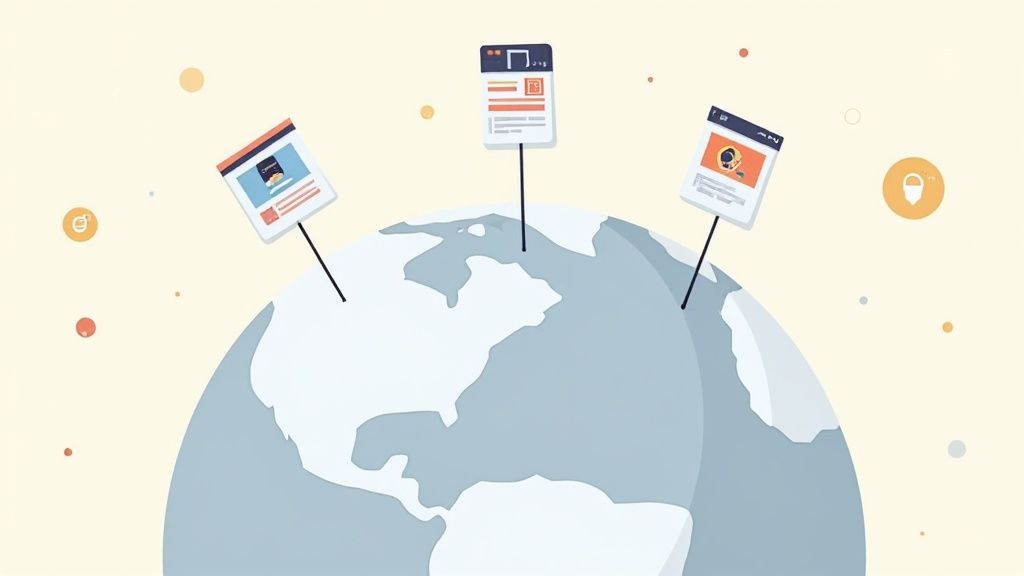
Running multiple Shopify stores is a fantastic way to scale, but it also means you’re managing a much larger digital footprint. This brings a whole new level of SEO and marketing complexity to the table. If you don't have a solid game plan, you'll find your stores fighting each other for traffic and leaving search engines utterly confused. The real goal here is to make sure each store stands on its own as a valuable, distinct destination for a specific audience.
The first and most immediate threat is duplicate content. When you have several stores selling similar—or identical—products, especially for different countries, you’re waving a big red flag at Google. Search engines might see your product pages as simple copies, which can torpedo your rankings and send the right customers to the wrong store.
Your Secret Weapon for International SEO: Hreflang
For any brand going global with separate storefronts, the hreflang tag isn't just a good idea; it's essential. This little snippet of code lives in your site's header and acts as a traffic controller for search engines, telling them exactly which version of a page to serve to users based on their language or location.
Think of it as giving Google a clear set of directions. A shopper in Germany searches for your product? The hreflang tag points them to your German store (de.yourbrand.com), not your U.S. one. Getting this right is non-negotiable for a successful international multi-store setup.
Here’s a quick look at what it does:
- Clarifies Regional Targeting: You can specify the language and country for every single URL (e.g.,
en-gbfor English-speaking users in the UK). - Solves Duplicate Content Worries: It tells search engines that your regional sites are alternate versions of each other, not lazy copies, which protects your hard-earned SEO authority.
- Boosts User Experience: Landing visitors on a page with their local language and currency is a massive win for engagement and, ultimately, conversions.
Don't think of
hreflangimplementation as just a technical chore. It's a strategic move that aligns your SEO efforts with your global ambitions, creating a seamless experience for customers and safeguarding your visibility across all markets.
Carve Out Unique Content and Marketing Funnels
To stop your stores from stepping on each other's toes, each one needs its own identity. This goes way beyond just translating text. You need to create content that speaks directly to the nuances of each market, even if your products are the same. Your U.S. store’s blog might be all about summer styles in July, while your Australian store is deep into its winter collection content.
This strategy of separation has to flow through your entire marketing stack. Of course, this assumes you already have a solid general e-commerce marketing strategy in place. From that foundation, you can build out distinct funnels for each store.
Here’s how you can practically structure this:
By building out these dedicated marketing channels, you're treating each Shopify store like the unique business it is. This focused approach doesn't just fix technical SEO issues; it lets you build stronger, more authentic relationships with each customer base, paving the way for sustainable growth across your entire brand portfolio.
Common Questions About Multiple Shopify Stores
Jumping into a multi-store strategy always kicks up a lot of dust. You’ve got questions, and getting straight answers is the only way you’ll feel confident pulling the trigger. Let's walk through some of the most common things merchants ask when they're thinking about managing more than one Shopify store.
Can I Have Multiple Stores on a Single Shopify Account?
This is usually the first question out of the gate, and the answer comes down to which Shopify plan you're on.
If you're running on Shopify Plus, the answer is a clear yes. Shopify Plus includes a feature called the Organization Admin, which is built specifically for this. It gives you a single, unified dashboard to manage every single one of your stores under one roof.
For everyone else on a standard plan (like Basic, Shopify, or Advanced), the answer is no. Each new store is its own separate entity. That means it gets its own subscription, its own login, and its own settings, even if you happen to use the same email to set them all up.
Do I Need Different Email Addresses for Each Store?
Nope, you don't. You can absolutely use the same email address to create and be the owner of multiple, separate Shopify stores. Shopify makes this pretty painless—when you log in, you'll see a simple store switcher that lets you hop between the different admin panels tied to your email.
While using one email keeps things simple from an ownership perspective, some bigger businesses do opt for separate emails just to keep operations clean. For instance, you might assign a unique email to the manager running a specific regional store. It really just depends on how your team is structured.
The bottom line is this: while standard plans force you into separate accounts for each store, you can still centralize the ownership under one email. It makes flicking between your different dashboards way easier.
How Much Does It Cost to Run Multiple Stores?
The costs stack up. You have to think of each store as its own independent business, complete with its own P&L. Every expense is multiplied across your storefronts.
Here’s what that looks like in practice:
- A separate Shopify subscription for every single store.
- Individual app subscriptions. If you need an app on three different stores, you're probably paying for it three times.
- Theme costs. If you buy a premium theme, that license is typically for one store only. Want it on another? You'll have to buy it again.
- Transaction fees are also calculated per store, based on its own sales volume and payment gateway.
It's so important to budget for these multiplied costs. Launching another Shopify store isn't just an operational move; it's a significant financial commitment. You need to plan carefully to make sure the whole ecosystem stays profitable.
At ECORN, we specialize in helping brands scale efficiently, whether that means optimizing a single powerhouse store or architecting a robust multi-store setup. Our team of Shopify experts can guide you through the complexities of design, development, and conversion rate optimization to fuel your growth. Discover our flexible subscription packages and let's build your ecommerce future together.






